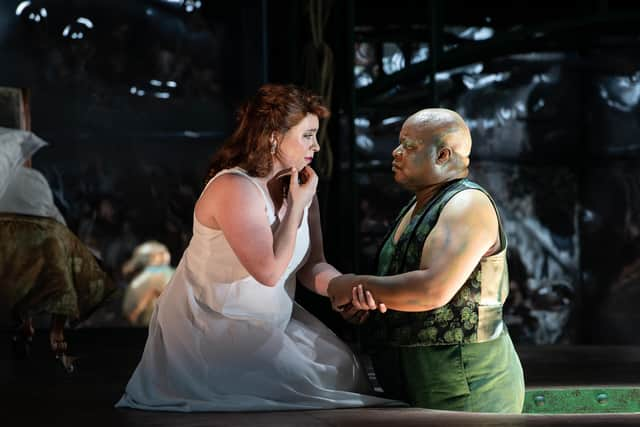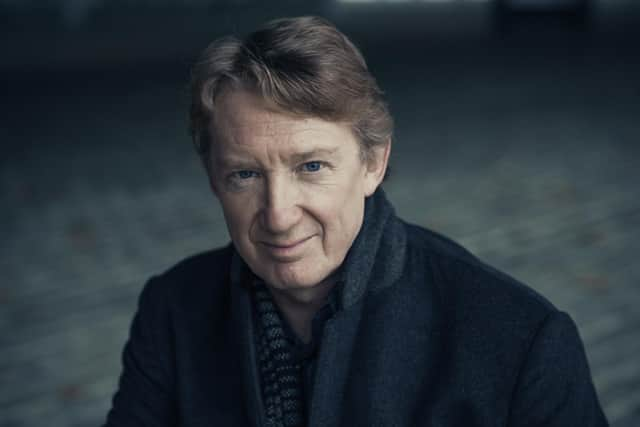Rusalka: Opera meets acrobatics at the Edinburgh International Festival


Garsington Opera’s new all-action take on Dvorak’s Bohemian fairytale opera Rusalka opened in June at the company’s own fairytale Buckinghamshire home – a fantastical lakeside glass and steel pavilion set amid the sumptuous grounds of Wormsley Estate.
“Bewitching colours”, “A genuine, if slightly sinister magic”, cooed the spellbound critics. By all accounts, this Rusalka – in a production created by Jack Furness, complete with circus performers, the award-winning Welsh soprano Natalya Romaniw in the title role, and the opulent Philharmonia Orchestra in the pit (as part of its wider Edinburgh International Festival residency) – goes big on enchantment and spectacle.
Advertisement
Hide AdDoes that make it a good fit for the opening week of the 75th Edinburgh International Festival? As the only staged opera this year, it runs over three nights at the Festival Theatre. “It’s a never-ending supply of magic, and the more we do it the more magical it seems,” promises Garsington’s artistic director, Glasgow-born conductor Douglas Boyd. “Rusalka gives us Dvořák at the absolute peak of his powers.” So yes, it fits the bill.
Completed in 1900, Rusalka is generally deemed his true operatic masterpiece. The theme suited him, a tale set within a magically aqueous and imaginary world (rusalki are water creatures). It also lent itself to the Wagnerian tone and structure embraced in his final three operas, of which this was the penultimate one.
Rusalka, a water nymph, wishes to become a human in order to capture the love of a Prince. The witch, Jezibaba, obliges, but with conditions: Rusalka must remain mute and the Prince must remain true to her. A Foreign Princess plots against them, the Prince rejects Rusalka, then repents. But the curse holds and a desperate kiss leads to the prince’s death. Rusalka disappears into the water.
Jaroslav Kvapil’s libretto, fashioned on Hans Christian Andersen’s The Little Mermaid, induced music from the Czech composer as vivid and intoxicating as his 1896 symphonic poem The Water Goblin. Wagnerian leitmotifs govern the opera’s liquid cohesion, but the lyrical fingerprints are forever Dvořák, alluringly Bohemian. Rusalka’s Song to the Moon is its most defining set piece.
“In terms of dramatic richness and musical inspiration it is basically unbeatable,” says Furness, no stranger to this opera, having assisted Antony McDonald in the latter’s 2016 production for Scottish Opera. “Natalya [Romaniw] sang the Foreign Princess in that one. I’m glad to see she’s got promotion.”


So has Furness, of course, now occupying the directorial hot seat and making the most of what he considers an embarrassment of riches: “You have the amazing melodic facility of Dvořák, and a really avant-garde libretto by Kvapil, who was completely immersed in the symbolist poetry and art of the time. The combo is immeasurably rich. Trying to get to the bottom of these suggestions, symbols and ambiguities is unbelievably fulfilling.”
Advertisement
Hide AdNot just for Furness, but for the whole Garsington team. Boyd, who will again have the Philharmonia players under his baton in Edinburgh, is totally sold on the engine-room potency of Dvořák’s luscious orchestral score. “Every emotion, every symbol is painted in sound,” he insists. “This is minute after minute of supreme masterpiece.”
And it helps inject essential realism into a world inhabited, on the face of it, by so many anonymous, generic characters, claims Furness, such as the Gamekeeper, the Kitchen Boy or the Foreign Princess. “What happens is so amazing, where these archetypes all ‘3D-ify’, allowing full-blooded humanity and character to push against the fairytale boundaries.”
Advertisement
Hide AdBut the real challenge is to strike a convincing balance that reconciles the natural world of water nymphs dominating Acts 1 and 3 with the troubled human world of Act 2. Boyd gets sceptical when any director says to him “this is what it’s about”. “What I love about Jack’s production is the ambiguity. It is so multi-levelled we’re left to draw our own thoughts.”


True enough, and as Edinburgh audiences will quickly discover, Furness and Boyd, together with designer Tom Piper, whose stage sets promise a veritable aquatic feast, have packed the Garsington production with endless stimuli to spark an orgy of conclusions. Cue the circus artists, swirling aerialists and acrobats, whose integration with the main cast promises a whole new visual dimension.
“This is not spectacle just for the sake of it,” Furness insists, a view that circus choreographer Lina Johansson is wholly on message with. The challenge, she says, has been to assimilate her performers with the singers in a way that muddies any distinction. “So, among the wood nymphs are three singers, three aerialists and three acrobats. The singers are up on ropes as well. What I didn’t want were the circus performers to dominate. It shouldn’t be a ‘ta-da!’ moment. I wanted them working in character and fitting into the whole narrative. Balance is key.”
Where that narrative rests, as it frequently does, and Dvořák throws the spotlight onto the orchestra alone, Johansson didn’t have to be asked twice to take the initiative. “There are so many beautiful moments like this when you can really go for full physical energy on stage,” she says. “The music is everything here, it’s so powerful, it’s what brings wonderful images to mind that inspire movement.”
For Lauren Jamieson, a Kilmarnock-born circus performer with a chemistry PhD, performing in Rusalka has opened her eyes to a world she never knew. “I’d never done anything outside circus before and really didn’t know what to expect with opera,” she confesses. “It’s been such an eye-opener. Working close-up with singers, understanding the physicality of their singing and how to adapt my choreography to theirs, getting to know this epic set, has all been really amazing.”


The challenge now for Garsington is to move its “epic set” to Edinburgh. Both theatres have big stages, says Boyd, and there’s plenty of room in the Edinburgh pit for the well-stocked Philharmonia. “The biggest difference lies in the audience space,” he explains. “Garsington holds 650 people and is a very intimate experience. With three times that capacity, the Edinburgh performances may require much bigger gestures on stage. It will offer a very different perspective.”
Advertisement
Hide AdFurness agrees. “There will be things we do at Garsington we can’t do in Edinburgh, but I see that as an opportunity to have another look at the opera and try some new things. I have this thing I say to myself that one production of a piece can’t encapsulate the entirety of the piece, and one night of one production can’t encapsulate the totality of the production. So for me, change and growth and flex is a good thing.”
One thing is for sure, both men feel very much at home north of the Border. Furness, besides his work on Scottish Opera’s Rusalka, later assisted in the company’s world premiere of Stuart MacRae’s Anthropocene in 2019. Immediately after Rusalka plays in Edinburgh, his new outdoor production of Bernstein’s Candide for Scottish Opera opens in Glasgow.
Advertisement
Hide AdBoyd, meanwhile, who made his name as a leading international oboist before switching to conducting, needs little encouragement to come home. “We should have been here with Rusalka in the pandemic year,” he says. “It could so easily not have happenedat all.”
Rusalka is at the Festival Theatre, Edinburgh on 6, 8 & 9 August.